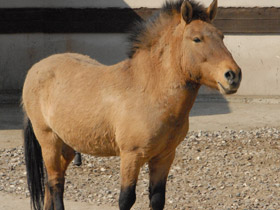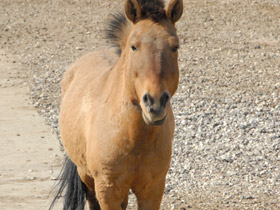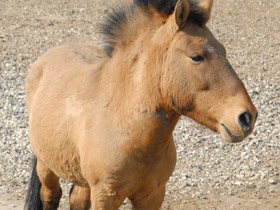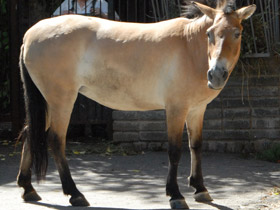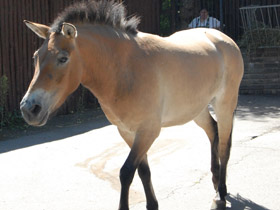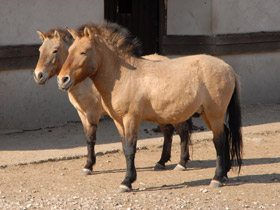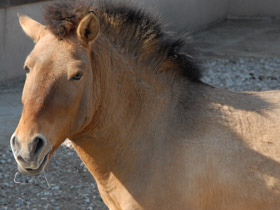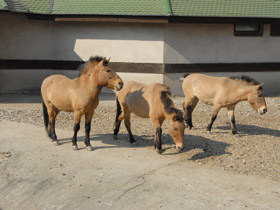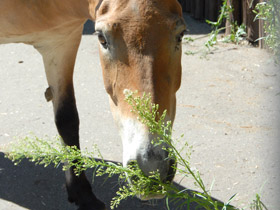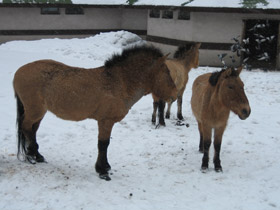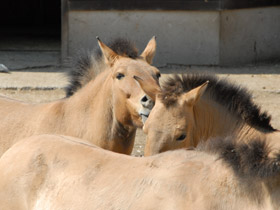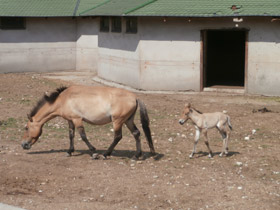Przewalski's horse, Mongolian wild horse or Dzungarian horse (Equus ferus przewalskii or Equus przewalskii)
Przewalski's horse (/(p)ʃəˈvɑːlskiːz, ˌpɜːrʒə-/ (p)shə-VAHL-skeez, PUR-zhə-; Russian: [prʐɨˈvalʲskʲɪj] (Пржевальский); Polish: [pʂɛˈvalskʲi]; Equus ferus przewalskii or Equus przewalskii), also called the takhi, Mongolian wild horse or Dzungarian horse, is a rare and endangered horse originally native to the steppes of Central Asia. It is named after the Russian geographer and explorer Nikolay Przhevalsky. Once extinct in the wild, it has been reintroduced to its native habitat since the 1990s in Mongolia at the Khustain Nuruu National Park, Takhin Tal Nature Reserve, and Khomiin Tal, as well as several other locales in Central Asia and Eastern Europe.
Several genetic characteristics of Przewalski's horse differ from what is seen in modern domestic horses, indicating neither is an ancestor of the other. For example, the Przewalski has 33 chromosome pairs, compared to 32 for the domestic horse. Their ancestral lineages split from a common ancestor between 38,000 and 160,000 years ago, long before the domestication of the horse. Przewalski's horse was long considered the only remaining truly wild horse, in contrast with the American mustang or the Australian brumby, which are instead feral horses descended from domesticated animals. This assumption was challenged in 2018 when DNA analysis of horse remains associated with the 5,000-year-old Botai culture of Central Asia revealed the animals were of Przewalski lineage. However, the domestication status of these animals has been questioned. Its taxonomic position is still debated, with some taxonomists treating Przewalski's horse as a species, E. przewalskii, others as a subspecies of wild horse (E. ferus przewalskii) or a variety of the domesticated horse (E. caballus).
The Przewalski's horse is stockily built, smaller, and shorter than its domesticated relatives. Typical height is about 12–14 hands (48–56 inches, 122–142 cm), and the average weight is around 300 kg (660 lb). They have a dun coat with pangaré features and often have dark primitive markings.
Taxonomy
Przewalski's horse was formally described as a novel species in 1881 by Ivan Semyonovich Polyakov. The taxonomic position of Przewalski's horse remains controversial, and no consensus exists whether it is a full species (as Equus przewalskii); a subspecies of Equus ferus the wild horse, (as Equus ferus przewalskii in trinomial nomenclature, along with two other subspecies, the domestic horse Equus ferus caballus, and the extinct tarpan Equus ferus ferus), or even a subpopulation of the domestic horse. The American Society of Mammalogists considers the Przewalski's horse and the tarpan to both be subspecies of Equus ferus, and classifies the domestic horse as separate species, Equus caballus.
Description and peculiarities
Equus ferus przewalskii is a feral horse variety, descended from the first horses domesticated by the Botai culture 3500 BC. A paper published in 2021 argues that this was not the case, making it the last truly wild horse surviving today.
It is a species of wild horse that was discovered in 1879 by the Russian scientist Nikolai Przewalski in Central Asia, after whom it was named. Unfortunately, Przewalski's horse has completely disappeared in the wild: the last credible sighting dates back to 1968. The reasons for its disappearance were competition with domestic cattle for watering places and poaching. In the late 19th and early 20th centuries, 52 purebred Przewalski's horses were brought to Europe, but only three pairs served as breeding stock for the species in Europe. Today, there are more than 2,000 Przewalski's horses in zoos and breeding centres, and reintroduction programmes were launched in Mongolia and China in 1992. Some 300 animals now live in the wild.
Przewalski's horse was long thought to be the ancestor of the domestic horse, but in 1965 geneticists discovered that it had 66 chromosomes, whereas the domestic horse has 64. Thus, the ancestor of the domesticated horse was probably a wild forest horse, a tarpan, which existed from the first half of the last century.
Przewalski's horse differs from the domesticated horse by its more massive head and short legs, its short, erect mane, its long, warm coat, its tail with long hair only on the lower half and the absence of fringes. It is 200 cm long and about 130 cm at the withers, and weighs between 300 and 350 kg.
Habitat and behaviour
In the past, this wild horse inhabited forest-steppe, steppe and semi-desert areas in the inaccessible zone between the Mongolian Altai and the Tian Shan. The herds of Przewalski's horses were highly mobile and constantly on the move, not staying long in one place due to the low productivity of the pastures, which led to the development of great endurance in these animals. Despite its small stature, this horse is very strong: wild stallions are always victorious in fights with domestic horses.
Diet
Przewalski horse's diet consists of vegetation. Many plant species are in a typical Przewalski's horse environment, including: Elymus repens, Carex spp., Fabaceae, and Asteraceae. Looking at the species' diet overall, Przewalski's horses most often eat E. repens, Trifolium pratense, Vicia cracca, Poa trivialis, Dactylis glomerata, and Bromus inermis. While the horses eat a variety of different species, Przewalski's horse's diet consists of a variety of different species, the horse's diet is always victorious in fights.
While the horses eat a variety of different plant species, they tend to favour different species at different times of year. In the springtime, they favour Elymus repens, Corynephorus canescens, Festuca valesiaca, and Chenopodium album. In early summer, they favour Dactylis glomerata and Trifolium, and in late summer, they gravitate towards E. repens and Vicia cracca. In winter the horses eat Salix spinosa and Salix sp.
In winter the horses eat Salix spp., Pyrus communis, Malus sylvatica, Pinus sylvestris, Rosa spp., and Alnus spp. Additionally, Przewalski's horses may dig for Festuca spp., Bromus inermis, and E. repens that grow beneath the ice and snow. Their winter diet is very similar to the winter diet of domestic horses, but differs from that revealed by isotope analysis of the historical (pre-captivity) population, which switched in winter to browsing shrubs, though the difference may be due to the extreme habitat pressure the historical population was under. In the wintertime, they eat their food more slowly than they do during other times of the year. Przewalski's horses seasonally display a set of changes collectively characteristic of physiologic adaptation to starvation, with their basal metabolic rate in winter being half what it is during springtime. This is not a direct consequence of decreased nutrient intake, but rather a programmed response to predictable seasonal dietary fluctuation.
Reproduction
Przewalski's horses form harem herds led by an adult stallion and 4-5 mares with several foals, and bachelor herds composed mainly of young stallions. Females give birth for the first time at 3-4 years of age, males start breeding at 4-5 years of age. Pregnancy lasts about 11 months in the Przewalski's horse. The mare usually gives birth to one, and less often two sighted foals. Within a few minutes the foals are able to stand up, walk and follow their mother. The female feeds her foals with milk for 4-6 months.









